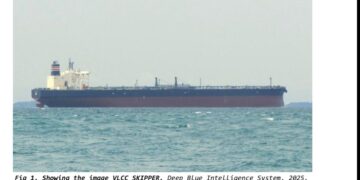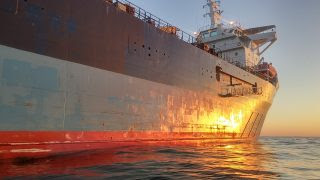New blends of marine fuels with
0.50% sulphur content can contain a large percentage of aromatic compounds,
which have a direct impact on black carbon emissions, a recently conducted
black carbon measurement campaign finds.
0.50% sulphur content can contain a large percentage of aromatic compounds,
which have a direct impact on black carbon emissions, a recently conducted
black carbon measurement campaign finds.
The results of the study were
cited in a submission made by Finland and Germany to the IMO’s Pollution
Prevention and Response (PPR) sub-committee for revision at its session
scheduled for February, seeking adequate action be taken.
cited in a submission made by Finland and Germany to the IMO’s Pollution
Prevention and Response (PPR) sub-committee for revision at its session
scheduled for February, seeking adequate action be taken.
The measurement campaign was
conducted by a German non-profit-making research institute WTZ Roßlau and was
assisted by MAN ES, DNV GL and Marena Ltd.
conducted by a German non-profit-making research institute WTZ Roßlau and was
assisted by MAN ES, DNV GL and Marena Ltd.
The project was funded by the
German Environment Agency.
German Environment Agency.
The study was carried out on the
recommendation from MEPC delegates to further develop BC measurement methods in
the light of the sulphur cap implementation and reducing the impact of black
carbon emissions from shipping on the Arctic.
recommendation from MEPC delegates to further develop BC measurement methods in
the light of the sulphur cap implementation and reducing the impact of black
carbon emissions from shipping on the Arctic.
Under the new regulation, which
entered into force on January 1, 2020, the limit for sulphur in fuel oil used
on board ships operating outside designated emission control areas is reduced
to 0.5% from 3.5%. This is expected to significantly reduce the amount of
sulphur oxides emanating from ships.
entered into force on January 1, 2020, the limit for sulphur in fuel oil used
on board ships operating outside designated emission control areas is reduced
to 0.5% from 3.5%. This is expected to significantly reduce the amount of
sulphur oxides emanating from ships.
The international shipping
community has had to switch to low sulphur fuel, start using scrubbers or turn
to LNG or other alternative fuels like LPG, methanol, biofuels or even ammonia.
community has had to switch to low sulphur fuel, start using scrubbers or turn
to LNG or other alternative fuels like LPG, methanol, biofuels or even ammonia.
However, the relatively new
marine fuel blends are yet to be put to the test when it comes to their
friendliness to the environment.
marine fuel blends are yet to be put to the test when it comes to their
friendliness to the environment.
Shipowners have voiced their
fears that the new fuel blends might pose a risk of contamination to a ship’s
systems, causing breakdowns and safety risks to the crew.
fears that the new fuel blends might pose a risk of contamination to a ship’s
systems, causing breakdowns and safety risks to the crew.
The latest study casts a darker
shadow on the new blends, increasing the pressure on bunker suppliers and
refineries to up their game.
shadow on the new blends, increasing the pressure on bunker suppliers and
refineries to up their game.
As indicated in the submission,
the emphasis of the measurement campaign was to analyse the BC emissions of
future hybrid fuels with 0.50% sulphur content from different sources and
different production processes, in comparison to two conventional fuels, heavy
fuel oil and Distillate Marine Fuel (DMA), and a possible future synthetic Gas
to Liquid (GtL) fuel, at varying engine ratings on a test bed.
the emphasis of the measurement campaign was to analyse the BC emissions of
future hybrid fuels with 0.50% sulphur content from different sources and
different production processes, in comparison to two conventional fuels, heavy
fuel oil and Distillate Marine Fuel (DMA), and a possible future synthetic Gas
to Liquid (GtL) fuel, at varying engine ratings on a test bed.
All tests were performed with the
same lube oil.
same lube oil.
The tested 0.50% sulphur fuels
have been ordered as possible sample mixtures from refinery-streams most likely
to be used in 2020. As informed, high aromatic content in future low sulphur
marine fuels after 2020 is expected.
have been ordered as possible sample mixtures from refinery-streams most likely
to be used in 2020. As informed, high aromatic content in future low sulphur
marine fuels after 2020 is expected.
The research found that new hybrid
fuels with 0.50% sulphur content used in the study contained a high proportion
of aromatic compounds in a range of 70% to 95%, which resulted in increased BC
emissions in a range of 10% to 85% compared to HFO and in a range of 67% to
145% (a factor of 2.45) compared to DMA.
fuels with 0.50% sulphur content used in the study contained a high proportion
of aromatic compounds in a range of 70% to 95%, which resulted in increased BC
emissions in a range of 10% to 85% compared to HFO and in a range of 67% to
145% (a factor of 2.45) compared to DMA.
“The results of this measurement
campaign imply that it is necessary to implement aromatic content, or H/C
ratio, in the specification of marine fuels of the ISO 8217 petroleum standard.
This would enable a better qualification of marine fuels with respect to their
environmental performance in terms of BC emissions and benefit their
characterization for ignition and combustion quality.
campaign imply that it is necessary to implement aromatic content, or H/C
ratio, in the specification of marine fuels of the ISO 8217 petroleum standard.
This would enable a better qualification of marine fuels with respect to their
environmental performance in terms of BC emissions and benefit their
characterization for ignition and combustion quality.
“It is suggested that the
International Organization for Standardization review ISO 8217 to include
specifications taking into account these results,” the study concludes.
International Organization for Standardization review ISO 8217 to include
specifications taking into account these results,” the study concludes.
World Maritime News.































































